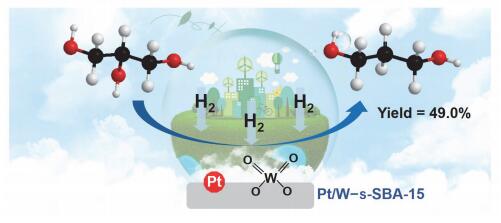摘要/Abstract

合成了孔道平行于短轴方向的W原位掺杂的介孔SBA-15分子筛(W-s-SBA-15), 以其为载体制备了Pt/W-s-SBA-15催化剂, 考察了催化剂中Pt、W负载量变化对甘油氢解制1,3-丙二醇(1,3-PDO)性能的影响. 采用多种手段对催化剂的形貌、活性组分Pt和W的存在状态、催化剂的酸性等性质进行了系统的表征. 催化剂评价结果表明, 随着Pt、W负载量的增加, 甘油的总转化率和液相转化率(CTL)提高, 而1,3-PDO选择性呈先升高后降低的火山型变化趋势. 在Pt负载量为4.0 wt%、W/Si物质的量比为1/480的4Pt/W-s-SBA-15(1/480)催化剂上, 在433 K、H2压力4.0 MPa、反应时间24 h的条件下, 甘油氢解制1,3-PDO的得率可达49.0%. 根据表征结果, 我们发现在Pt/W-s-SBA-15催化剂上的甘油转化率与Pt活性比表面积直接相关, 而小的Pt粒径、Pt与单分散WO4之间密切的协同作用, 则有助于提高1,3-PDO的选择性.
关键词: 短孔道W-SBA-15, 甘油氢解, 1,3-丙二醇, 铂, 钨
The mesoporous SBA-15 molecular sieves doped in situ by W with channels parallel to the short axis (W-s-SBA-15) were synthesized by using decane as cosolvent and trimethylbenzene (TMB) as pore-expanding agent, which were used as the supports for the preparation of the Pt/W-s-SBA-15 catalysts. The effect of the loadings of Pt and W on the catalytic performance in glycerol hydrogenolysis to 1,3-propanediol (1,3-PDO) was investigated. The morphology, chemical states of Pt and W, and acidity of the catalysts were systematically characterized by using Brunauer-Emmett-Teller (BET), scanning electron microscopy (SEM), transmission electron microscopy (TEM), CO pulsed adsorption, X-ray photoelectron spectroscopy (XPS), Raman, ultraviolet-visible diffuse reflectance spectra (UV-Vis DRS), Fourier transform infrared spectroscopy (FT-IR) and FT-IR of adsorbed pyridine analysis (Py-IR). The BET and TEM results revealed that there are two kinds of pores in the structure: the mesoporous channels parallel to the short axis and honeycomb-like macropores. The Pt dispersion and active surface area calculated from CO chemical adsorption, firstly increased and then decreased with the increase in the Pt and W loadings. The highly dispersed tungsten species were assigned to the single-site WO4 on the basis of the characterization results of Raman, UV-Vis DRS, and FT-IR. The XPS results indicated that the amount of the Pt-O-Si/W linkages and the Pt δ+/(Pt 0+Pt δ+) ratio are the highest on the 4Pt/W-s-SBA-15(1/480) catalyst which promote the dispersion of the Pt particles on the catalyst surface. With the increase in the loadings of Pt and W, the conversion of glycerol and the conversion of glycerol to liquid products (CTL) increased monotonically, while the selectivity to 1,3-PDO experienced a volcanic-type evolution. At the reaction temperature of 433 K, H2 pressure of 4.0 MPa, and reaction time of 24 h, the highest yield of 1,3-PDO of 49.0% was resulted on the 4Pt/W-s-SBA-15(1/480) catalyst. It is identified that the conversion of glycerol on the Pt/W-s-SBA-15 catalysts is proportional to the active surface area of Pt on the catalyst, while the small Pt particle size and the strong synergy between Pt and the highly dispersed WO4 species are advantageous to the formation of 1,3-PDO.
Key words: short-channel W-SBA-15, glycerol hydrogenolysis, 1,3-propanediol, Pt, W
PDF全文下载地址:
点我下载PDF
